Straightforward actions trump mealy-mouthed PR, sorry beats sophistry. Nicely done.
For the backstory, see this article: Led Down the Garden Path.
Straightforward actions trump mealy-mouthed PR, sorry beats sophistry. Nicely done.
For the backstory, see this article: Led Down the Garden Path.
The Shopify Fund is a one million dollar pool of money that we’re using to encourage the development of apps built on Shopify’s ecommerce platform. We’ve funded the first four apps, which I’ve summarized in this article, and we’re on the lookout for more! The video above (4 minutes, 11 seconds) explains both Shopify apps and the Shopify Fund.
If you’re an app developer and want to get in on some of this Shopify Fund action, take a look at the Shopify Fund page and use the form to tell us about your app idea! We might fund it.
If you’ve already applied for the Shopify Fund but aren’t one of the first four to get funded, keep working on your app idea and submit it to the Shopify App Store! The fund isn’t just about getting new apps built, but also enabling developers to work on improvements to their apps. Submit your app, go to the Shopify Fund page and tell us about it! We might fund that development.
If you’ve got an app in the Shopify App Store already and you have ideas for a revision, go to the Shopify Fund page and let us know what they are – we might fund that revision!
Update: Path’s CEO has apologized and promised to delete any collected data. See this entry.
It’s the top story on Techmeme at this moment: the socially-networked “lifestreaming” iPhone app known as Path uploads your entire address book to its servers.
This fact was discovered by Denso developer Arun Thampi when he decided that he’d build a Mac OS X client for Path at his company’s hackathon. To do this, he decided to observe the API calls that Path made to its servers only to discover that the data for his Contacts app – names, email addresses, phone numbers – was getting HTTP POSTed to https://api.path.com/contacts/add. To see the the full story, be sure to read Arun’s blog entry on the matter.
Path CEO Dave Morin sent a reply to Arun, explaining that the data is used only to help users connect to their friends and family and nothing more. He also said that they “proactively rolled out an opt-in for this” on their Android client a few weeks ago and will include the same opt-in feature on the next version of the iOS client. For anyone who has the current version on their iPhone, that feature came a little too late. This is bad, and the fact that Path has recently been working on “proactive” fixes suggests that they know it.
I have Path on my phone because it’s a gorgeous app and a number of my friends and coworkers were on the network and encouraging me to take it for a spin. That means that my contact info resides on Path’s servers. A good chunk of my life is public by my own choice, so I can live with Path having my own address and phone number, but nobody else on my contacts list signed up for that. Furthermore, inclusion in my contacts list doesn’t necessarily imply that they’re someone I want in my social network graph. But Path can’t discern between my friends and family and others like my ex-wife, my local cab company or that client in Australia who just had a couple of questions. You’d think that Path would’ve learned the lessons of “Fuck You Google”, in which a woman wrote about how Gmail overshared her info with her abusive ex-husband.
It’s an even bigger problem in the case of celebrities, who presumably have other celebs’ numbers in their on-phone Rolodexes. Take a look at this tweet from Alyssa Milano:
. @Path .. Is there an OPT OUT of you having my ENTIRE iphone address book on your server ? /via @heykim
— Alyssa Milano (@Alyssa_Milano) February 8, 2012
The response, by the way:
@Alyssa_Milano shoot me a note at dave at path dot com.
— Dave Morin (@davemorin) February 8, 2012
And did it also upload my notes about people? (Yes, I’m one of those people who actually uses the “Notes” field in Contacts. For business contacts, it’s all part of the schmooze; for friends and family, it’s so I remember things like their likes, dislikes, birthdays, anniversaries and other little things.)
In the comments to Arun’s article, iOS developer Matt Gemmell suggests the following to Dave Morin:
Why are you uploading the actual address book data, rather than (say) generating hashes of the user’s email addresses locally, then uploading just those hashes? You’d be able to do friend-finding that way, and similarly if you uploaded hashes of all email addresses in the user’s address book, you’d be able to do your notifications of when a friend joins. At no point would your servers ever need to see the actual email addresses or phone numbers from our contacts.
He also points out that sending the entire Contacts database to their servers may be a violation of the App Store’s terms and conditions. In fact, section 17.1 of that T&C states:
17.1: Apps cannot transmit data about a user without obtaining the user’s prior permission and providing the user with access to information about how and where the data will be used.
Dave Morin’s been firefighting ever since the news about Path got out. He’s stayed on message with the “we’re not trying to be evil here” line, but with the faith in Google’s “Don’t be evil” mantra pretty much gone, it’s not very reassuring. On the bright side, he has made it clear that if you want your address book and even your Path account deleted from their servers, you have but to send an email to service@path.com.
Update (February 8, 2012): Mike Arrington has put online what I’d been thinking (but didn’t think Path would ever do without a lot of pressure): they should simply delete all the address book data they pulled. It would be an excellent goodwill gesture; let’s see if they take up his suggestion.
(Little hint, Dave: if you keep overusing “proactive” and “proactively” the way you have in your responses and tweets, it becomes a filler word, like “um” and “uh”. Especially when such “proactivity” seems limited to stating that you’re not doing anything wrong.)
There’s been some freaking out over Path in the comments for Arun’s blog entry as well as in other venues online, but it’s time to let cooler heads prevail. Let’s see what Path does in the next 48 hours – as Arun himself puts it, “I hope we can keep calm and continue to discuss this sensibly”.
If you’re developing software that makes use of people’s personal info, let this be a lesson!
Does the diagram below pique your interest?
How about this shell session?
If both of these images have made you think “tell me more!”, you’ll want to:
 Me interviewing Jeff at the Microsoft Professional Developer Conference in October 2008.
Me interviewing Jeff at the Microsoft Professional Developer Conference in October 2008.
Jeff Atwood made the web better when he co-founded Stack Overflow and Stack Exchange. These high-signal, low-noise questions-and-answers online places have grown from a single site whose audience was software developers to a network of 80 or so that cover an increasing number of topics and interests.
Yesterday, he announced that effective March 1st, 2012, he will no longer be part of the day-to-day operations of Stack Exchange. It’s a startup, and startup life and family life, especially with young children, can be very incompatible. Jeff has a young boy and two twin girls whose age can still be measured in days. He’s decided to take more time to be with his family, and I can’t help but approve.
Thanks for everything, Jeff, and we’ll see you out there!
Update: Newsy have put together a piece summarizing the tech news’ reaction to the Samsung Galaxy Note ad. It’s at the end of this article – check it out!
 Even if you missed the big game, you can still catch the Superbowl ad for the Samsung Galaxy Note. Directed by Bobby Farrelly (one of the Farrelly Brothers, creators of high-larious films like Dumb and Dumber, There’s Something About Mary, and unfortunately, the upcoming Three Stooges Movie), it’s a continuation of the series of ads that poke fun at Apple fandom. It opens with a scenes from lineups outside Apple stores. The bored Apple fanatics are tethered to their white earbuds and awaiting their next gift from the gods when one of them sees a passer-by with a Samsung Galaxy Note.
Even if you missed the big game, you can still catch the Superbowl ad for the Samsung Galaxy Note. Directed by Bobby Farrelly (one of the Farrelly Brothers, creators of high-larious films like Dumb and Dumber, There’s Something About Mary, and unfortunately, the upcoming Three Stooges Movie), it’s a continuation of the series of ads that poke fun at Apple fandom. It opens with a scenes from lineups outside Apple stores. The bored Apple fanatics are tethered to their white earbuds and awaiting their next gift from the gods when one of them sees a passer-by with a Samsung Galaxy Note.
“Whoa, whoa, whoa – what is that?” he asks.
“Here,” says the passer-by, walking towards soon-to-be-ex-Apple-worshipper. “It’s the new Samsung Galaxy Note.”

Then comes the kicker: “It’s got a pen?” That’s right: it’s bringing back the stylus, the very thing that iOS devices put out of style.
After that, the Apple fans break free of their self-imposed imprisonment in line – a line that Samsung probably wishes they had – and partying, powered by The Darkness’ hit I Believe in a Thing Called Love – ensues.
It’s a little hard to tell from the ad, but the Galaxy Note is bigger than your standard phone; in fact, it’s bigger than even the biggest of the notoriously oversized Samsung phones. Size-wise, it’s in Newton territory: smaller than a tablet, a tad too big to fit into most pockets. Perhaps they’re also trying to bring cargo pants back:
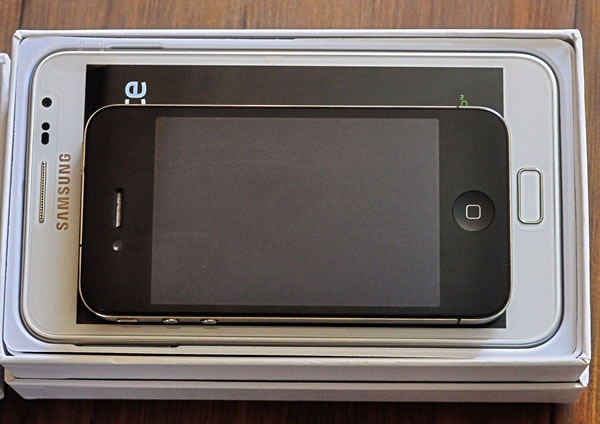 Photo from TechInferno.
Photo from TechInferno.
I’m reminded of this promotional photo, where Sony tried to convince you of how portable their smallest VAIO was:

It sits somewhere in the “Zone of Suck” from my 2009 article, Fast Food Apple Pies and Why Netbooks Suck (I’m going to have to revise the graphic to include tablets as well as the Galaxy Note):
As for what it’s like to use the device, consider this review in TechInferno. The reviewer loves the Galaxy Note and says he’s never going back to an iOS device, but he damns it with his faint praise:
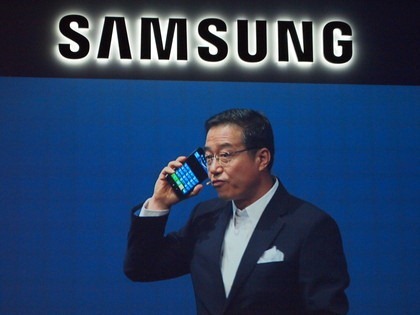 You know what they say about guys with big phones…
You know what they say about guys with big phones…
I think I’ll be sticking with my iPhone 4S and iPad 2 a little while longer, thanks.
Newsy’s got a good piece summarizing the tech press’ and pundits’ reaction to the Galaxy Note ad. Check it out!
The Ruby Job Fair isn’t your father’s (or mother’s) job fair. And why would it be? After all, it’s an event put on by Meghann and the other fine folks at Unspace, the development shop that gave the world the mind-blowingly amazing RubyFringe and FutureRuby conferences.
You may have heard or learned from painful experience that job fairs are like this:

Unspace’s gatherings are a little more like this:


The two photos above were taken at an event that they threw called Technologic, which took the typical evening tech seminar on its ear. You can read more about it in my blog entry about that event.
If you’re looking for work that involves Ruby programming and you’re going to be in downtown Toronto on Friday, you should register to attend the Ruby Job Fair. It’ll be your chance to meet prospective Ruby employers and their representatives, which will include me – I’ll be there as the Shopify Guy. You won’t be able to miss me: I’ll be the one with the accordion…

The quick details about Ruby Job Fair:

Normally, I’d start with a description of Shopify’s hacker ethic, how it’s a great-yet-casual work environment, that everyone gets a MacBook Pro or MacBook Air as their work machine, that and how fun and rewarding it is to work there. That’s all true, but I’m sure every software development shop has a spiel along the same lines. So I’ll give you that spiel later. How ‘bout I answer the question that might be lingering somewhere in your mind: “Are you guys still going to be around a year from now, or are you going to crash and burn and leave me looking for work again?”
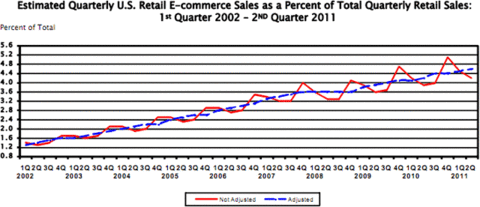
For starters, we’re in the ecommerce business, and business is good. How good? In the second quarter of 2011 – remember, that’s only April, May and June – ecommerce sales in the U.S. were $48 billion. And impressive as that figure may be, ecommerce is still less than 5% of all retail.
Ecommerce is growing too, and it’s becoming a bigger and bigger part of how people buy and sell things; in fact, ecommerce sales are growing at over twice the rate of all retail.
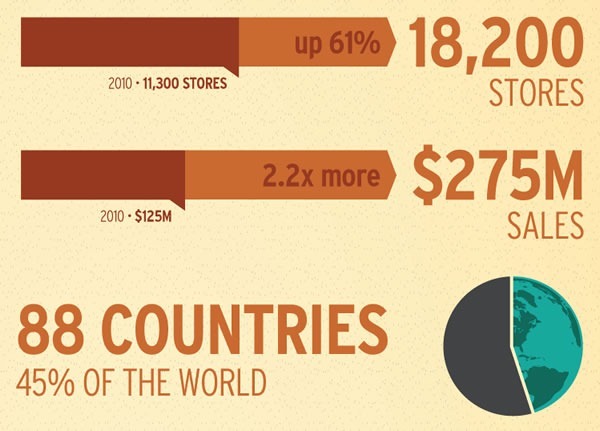
Going from ecommerce in general to Shopify in particular, things are looking great there too. We went from 11,000 to 18,000 shops in 2011, and as of this writing, we’ve crossed the 20,000 mark. The 2010 total sales from all our shops was $125 million, and we more than doubled that last year, moving $275 million in products.

On top of being a profitable business, we also have had two rounds of funding, which gave us a grand total of $22 million invested in us. That money’s being used to grow the company in all sorts of ways, from the Shopify Fund to things like our recent acquisition of Select Start Studios, a mobile dev company.
Here’s what was waiting for me at my desk on my first day at Shopify. I felt like a kid in a candy store:
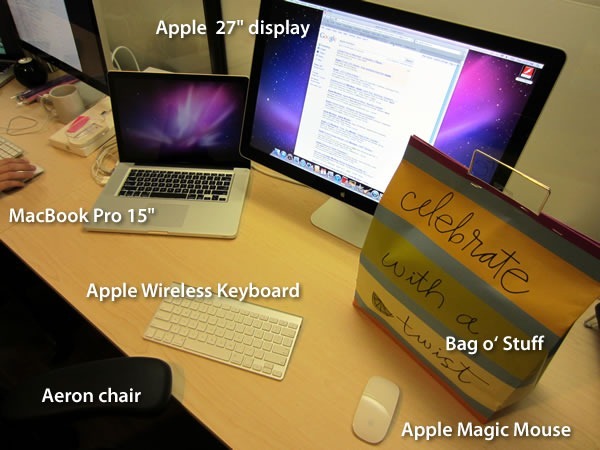
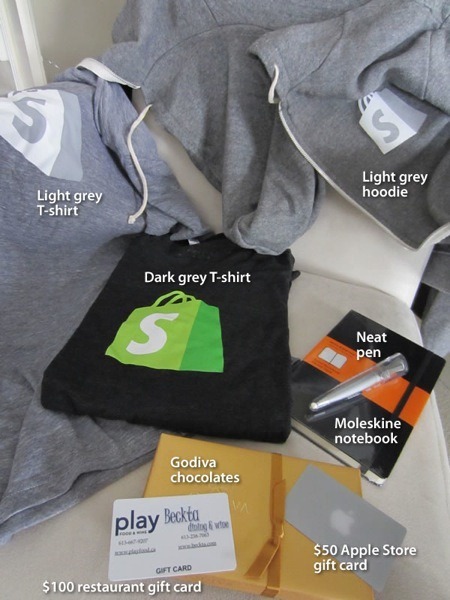
We want to do good work, and good work needs good tools.
Good work needs a good physical environment, and we’ve got that in spades. Check out our brand-new office. Here’s the reception desk, which is occupied by Laura, our gets-stuff-done-so-we-can-get-stuff-done person:
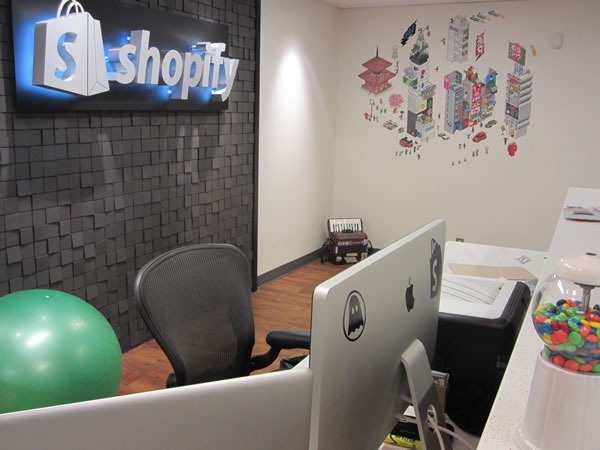
We believe that small, agile teams work best, so we’ve broken our space into offices just like the one below, and each team is free to set up and decorate their space as they see fit. They’re not normally this crowded; the photo below is from the party we had on Friday:

I’m in the developer advocate/evangelism group, and we went with this pop art wall covering in our zone:

Others on our team have some great illustration talents and put them to good use:
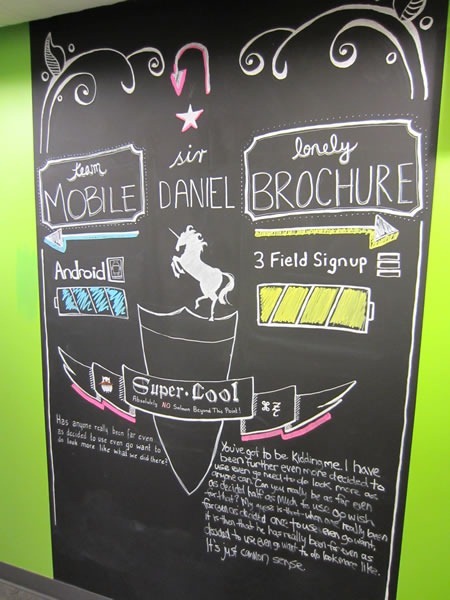
Sure, we’ve got your standard meeting rooms (and they’re pretty nice for what they are):

…but one of them’s equipped with an Xbox and Kinect:

And then there are little gems like this room:
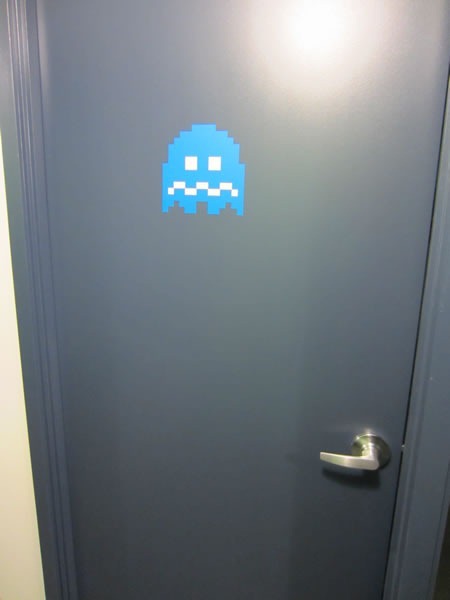
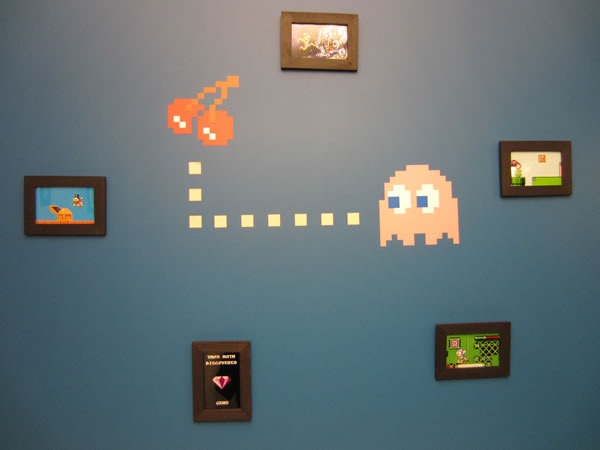
It’s the 8-bit paradise. I spent an afternoon working on API docs in the room, a nice quiet space where you can concentrate, after which you can reward yourself with classic 1980s console action!
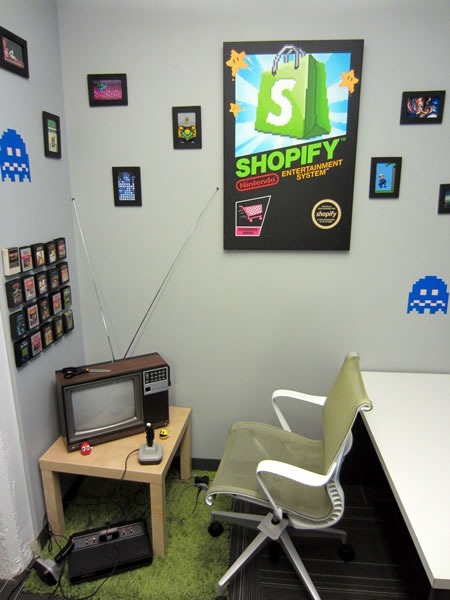
This poster was created by our design team, a very talented bunch:
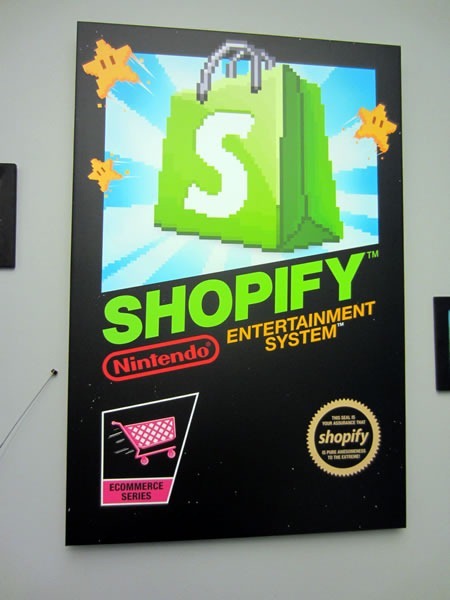
We’ve got a fine collection of vintage cartridges:
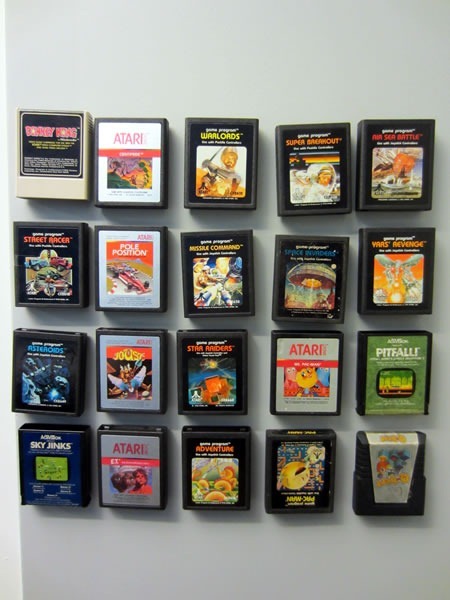
Ah, the Atari 2600. It takes me back to my wonderfully misspent youth:

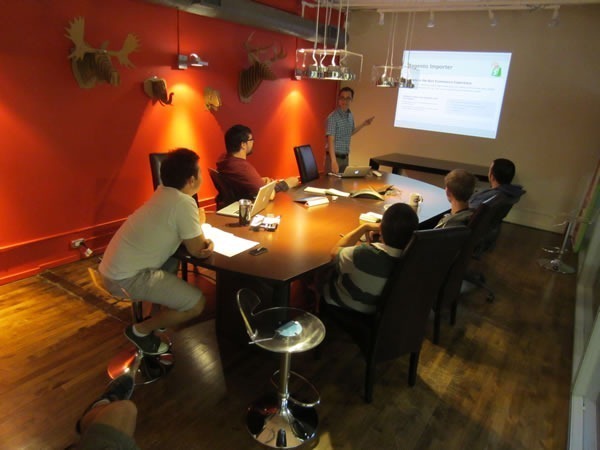
One of the reasons that Shopify is successful is that we’ve worked out some ways of doing things. We’re all about “drawing the owl”, and the way we do things is an in the service of drawing that owl. (Don’t worry, you’ll soon know what “drawing the owl means”.)
Shopifolks – that’s what I like to call people at Shopify – are self-starters. Once given a goal, they use their skills, knowledge and good judgement to do the work necessary to hit that goal. They get stuff done. They’re what Y Combinator’s Paul Graham calls “resourceful”.
I recently wrote about how my team (and pretty much every other team at Shopify) gets things done, but it’s worth repeating:

If Shopify looks like the sort of place where you’d like to work, and if you think you’ve got the skills, enthusiasm and passion to work with us, come see at Ruby Job Fair. I’d be happy to answer all your questions and hook you up!